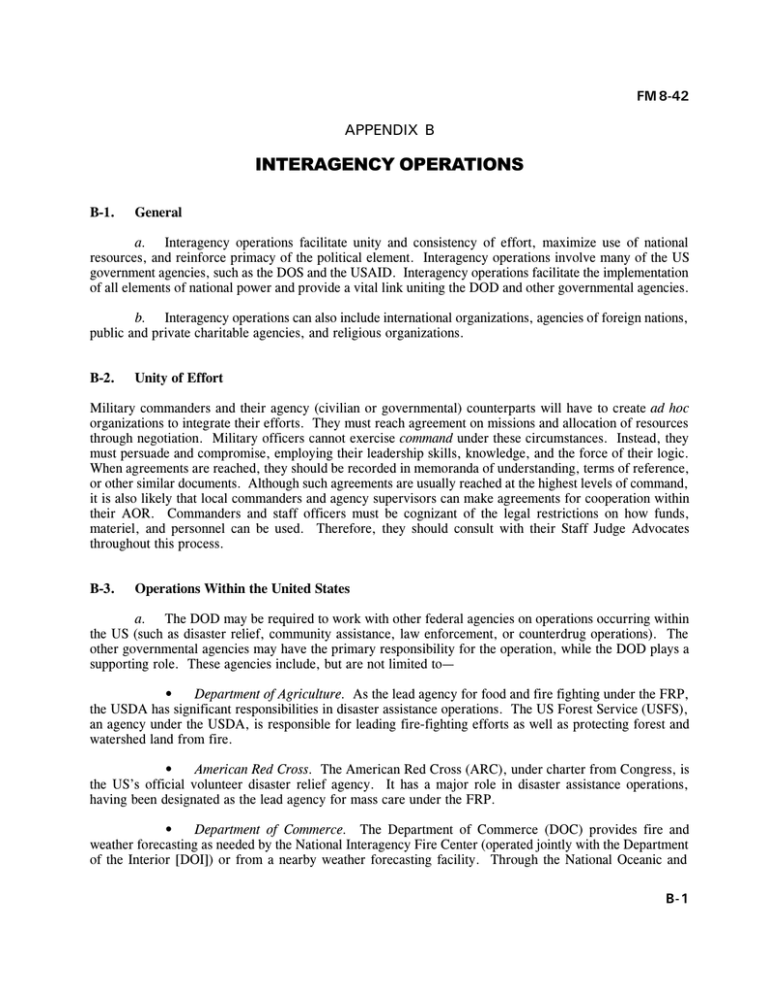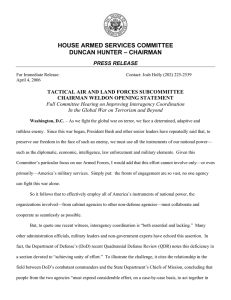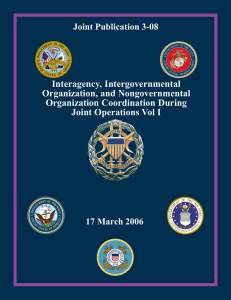INTERAGENCY OPERATIONS APPENDIX B
advertisement

FM 8-42 APPENDIX B INTERAGENCY OPERATIONS B-1. General a. Interagency operations facilitate unity and consistency of effort, maximize use of national resources, and reinforce primacy of the political element. Interagency operations involve many of the US government agencies, such as the DOS and the USAID. Interagency operations facilitate the implementation of all elements of national power and provide a vital link uniting the DOD and other governmental agencies. b. Interagency operations can also include international organizations, agencies of foreign nations, public and private charitable agencies, and religious organizations. B-2. Unity of Effort Military commanders and their agency (civilian or governmental) counterparts will have to create ad hoc organizations to integrate their efforts. They must reach agreement on missions and allocation of resources through negotiation. Military officers cannot exercise command under these circumstances. Instead, they must persuade and compromise, employing their leadership skills, knowledge, and the force of their logic. When agreements are reached, they should be recorded in memoranda of understanding, terms of reference, or other similar documents. Although such agreements are usually reached at the highest levels of command, it is also likely that local commanders and agency supervisors can make agreements for cooperation within their AOR. Commanders and staff officers must be cognizant of the legal restrictions on how funds, materiel, and personnel can be used. Therefore, they should consult with their Staff Judge Advocates throughout this process. B-3. Operations Within the United States a. The DOD may be required to work with other federal agencies on operations occurring within the US (such as disaster relief, community assistance, law enforcement, or counterdrug operations). The other governmental agencies may have the primary responsibility for the operation, while the DOD plays a supporting role. These agencies include, but are not limited to Department of Agriculture. As the lead agency for food and fire fighting under the FRP, the USDA has significant responsibilities in disaster assistance operations. The US Forest Service (USFS), an agency under the USDA, is responsible for leading fire-fighting efforts as well as protecting forest and watershed land from fire. American Red Cross. The American Red Cross (ARC), under charter from Congress, is the USs official volunteer disaster relief agency. It has a major role in disaster assistance operations, having been designated as the lead agency for mass care under the FRP. Department of Commerce. The Department of Commerce (DOC) provides fire and weather forecasting as needed by the National Interagency Fire Center (operated jointly with the Department of the Interior [DOI]) or from a nearby weather forecasting facility. Through the National Oceanic and B-1 FM 8-42 Atmospheric Administration, it provides scientific support for response and contingency planning in coastal and marine areas. Department of Education. The Department of Education (DOEd) establishes policy for, administers, and coordinates most federal assistance to education. It supports information and planning for disaster and environmental assistance operations. The DOEd may also become involved in selected Army community assistance programs that address education and training. Department of Energy. The Department of Energy (DOE) is the FRPs lead agent for energy. It provides the framework for a comprehensive and balanced national energy plan through the coordination and administration of the federal governments energy functions. Environmental Protection Agency. As lead agency for hazardous material response under the FRP, the Environmental Protection Agency (EPA) has a significant role and responsibilities in both disaster and environmental assistance operations. It provides for a coordinated response by federal departments and agencies, state and local agencies, and private parties to control hazardous material spills. Federal Emergency Management Agency. The FEMA is the federal governments executive agency for implementing federal assistance to a state and its local governments. In most cases, it implements assistance in accordance with the FRP. General Services Administration. The General Services Administration (GSA) is the lead agency for resource support under the FRP. Having extensive expertise, both in contracting and providing services, GSA is an invaluable player in disaster relief and environmental assistance operations. Department of Health and Human Services. The DHHS is the lead agency for health and medical services under the FRP. The USPHS, an agency under DHHS, leads this effort by directing the activation of the NDMS. The DHHS is also responsible for assisting with the assessment of health hazards at a response site and the protection of both response workers and the general public. Department of the Interior. As a support agency under the FRP, the DOI provides support for disaster and environmental assistance operations. Department of Justice. The Department of Justice (DOJ) plays a significant role in law enforcement and counterdrug operations. The Drug Enforcement Agency (DEA) is the DOJs lead agency for counterdrug operations. As the governments legal representative, the DOJ becomes involved in law enforcement operations, community assistance operations, and disaster and environmental assistance operations. Department of Labor. The Department of Labor (DOL), through the Occupational Safety and Health Administration, conducts safety and health inspections of hazardous waste sites and responds to emergencies. Department of State. The DOS advises the President in the formulation and execution of foreign policy. Its primary mission in the foreign relations arena is to promote the interests of the US B-2 FM 8-42 overseas. In this capacity, the DOS manages USAID and the US Information Agency. The DOS also has a support role in disaster and environmental assistance events or domestic counterdrug operations having international implications. Department of Transportation. As the lead agency for transportation under the FRP, the Department of Transportation (DOT) coordinates federal transportation in support of federal agencies, volunteer agencies, and state and local governments. Department of Treasury. The Department of Treasury, through its agency the US Customs Service (USCS), regulates goods, people, and vehicles entering or leaving the US and its territories. National Weather Service. The National Weather Service (NWS) predicts, tracks, and warns of severe weather and floods. National Communications System. The National Communications System (NCS) is the lead agency for communications under the FRP. It consists of representatives from 23 federal agencies and operates under the authority of the GSA. The NCS provides communications support to federal, state, and local response efforts and is charged with carrying out the National Telecommunications Support Plan to ensure adequate communications following disasters. Nuclear Regulatory Commission. The Nuclear Regulatory Commission (NRC) is responsible for the Federal Radiological Emergency Response Plan (FRERP). Its responds to the release of radioactive materials by its licensees. b. B-4. For additional information on these agencies, refer to FM 100-19. Operations Outside the United States a. relations. b. The DOS is organized to provide Foreign policy advice to the President. Nation-to-nation representation throughout the world. United States interdepartmental coordination in various nations with whom the US has Worldwide information services. Key planners within the DOS include Secretary of State. He is the principal foreign policy adviser to the President and is responsible for the overall direction, coordination, and supervision of US foreign relations and for the interdepartmental activities of the US government overseas. B-3 FM 8-42 Ambassador and United States country team. The US country team is composed of senior representatives of all in-country US government departments. The ambassador represents the President as Chief of Mission (COM), but takes policy guidance from the Secretary of State through regional bureaus. He is responsible for all US activities within the country to which accredited and interprets US policies and strategies regarding the nation. The composition of the country team varies widely depending on specific US national interests in the country, the desires of the COM, the situation within the country, and the number and level of presence of US agencies. The ambassadors authority does not, however, include the direction of US military forces operating in the field when such forces are under the command of a US area military command. The CINC usually participates as a member of the country team, even though he is not a member of the diplomatic mission and may not be physically located in the country. Political advisor. A political advisor (POLAD) is a foreign service officer from the DOS. The DOS assigns a POLAD to each combatant commander and may authorize one to the American operational commander during multinational operations. The POLAD is a valuable asset possessing appropriate regional knowledge and language skills who can assist the combatant commander in translating political objectives into military objectives. Further, the POLAD can facilitate cooperation between the primary US political and military actors. The POLAD often has the ability to move freely throughout an AO and work with a wide range of different parties that might not work with US military personnel. Nongovernmental organizations/private volunteer organizations. The primacy of political considerations in multinational operations demands a recognition of the importance of nonmilitary participants. Nongovernmental organizations and PVOs are frequently on the scene before military forces and are willing to operate in high-risk areas. They will most likely remain long after military forces have departed. The sheer number of lives they affect and resources they provide enables the NGO and PVO community to wield a great deal of power. Because of their capability to respond quickly and effectively to crisis, NGOs and PVOs can lessen the CMO resources that a commander would otherwise have to devote to an operation. Examples of such organizations include B-5. International Society of the Red Cross and Red Crescent. United Nations High Commissioner for Refugees. Medecine Sans Frontieres. Others. Military Effort As mentioned in paragraph B-2, the military may not be the lead player in interagency operations. In OCONUS operations, the Office of the Secretary of Defense and the joint staff coordinate interagency operations at the strategic level. This coordination establishes the framework for coordination by commanders at the operational and tactical levels. B-4 FM 8-42 The combatant commander is the central point for plans and implementing theater and regional strategies that require interagency coordination. The combatant commander may establish an advisory committee to link his theater strategy to national policy goals and objectives of DOS and concerned ambassadors. Military personnel may coordinate with other US government agencies while operating directly under the ambassadors authority, while working for a SAO, or while assigned to a regional combatant commander. Coordination among DOD and other US government agencies may occur in a country team or within a combatant command. Military personnel working in interagency operations must ensure that the ambassador and the combatant commander know and approve of all programs. Legitimizing authorities determine specific command relationships for each operation. B-6. Combat Health Support Implications in Interagency Operations Depending upon the type of operation (such as disaster relief, domestic support, or nation assistance), the type and scope of CHS will vary. This support is based on the unique requirements for the operation, the desired end state, and the duration of the operation. The delivery of health care, health education, or advice and consultation by military CHS personnel will usually play a supporting role in the overall operation rather than a primary one. The CHS commander must ensure that Legal guidance throughout the operation is obtained to ensure that he adheres to any legal restrictions on the use of military personnel, materiel, and funds. A determination as to who is eligible for care by military health care professionals or in military MTFs is made and correctly implemented. Credentialing, scope of practice, and malpractice liability requirements are established and enforced for nonmilitary medical professionals operating within a US military MTF or sponsored program. Combat health support planners have a complete understanding of the capabilities available from other agencies involved in the operation. (Comprehensive planning will ensure that a duplication of services between agencies is avoided, that the use of scarce resources is maximized, and that the cost of the operation is contained. The CHS planner must also document sources for the reimbursement of expenses [resources expended] [personnel and materiel], where applicable.) The CHS contingent receives or develops SOPs that describe its functions, responsibilities, and procedures for each CHS functional area. This ensures the efficient and effective delivery of health care by delineating responsibilities, identifying sources of support, and minimizing confusion in the implementation of support. Preventive medicine assets are available to ensure adequate field sanitation and food hygiene measures are taken in US troop areas when housing and food support is provided for by non-US governmental agencies. B-5 FM 8-42 Veterinary assets are available to ensure food wholesomeness and quality when food procurement and support are provided by non-US governmental agencies. B-6







